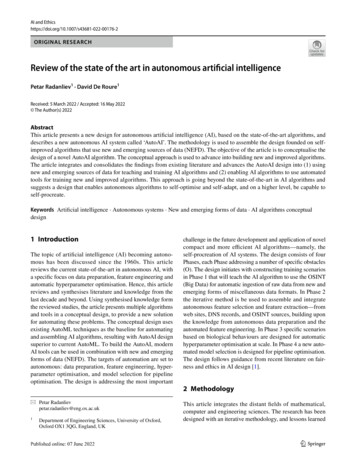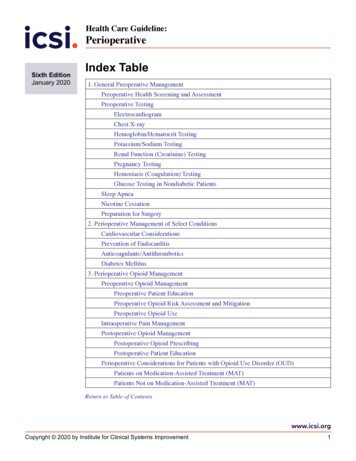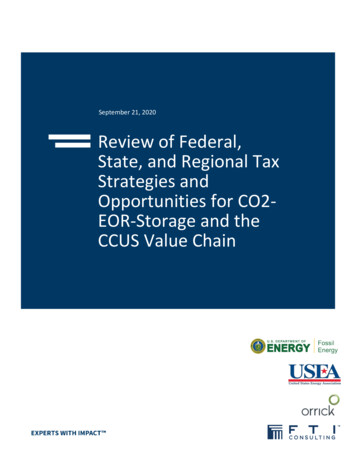
Transcription
AI and IGINAL RESEARCHReview of the state of the art in autonomous artificial intelligencePetar Radanliev1 · David De Roure1Received: 5 March 2022 / Accepted: 16 May 2022 The Author(s) 2022AbstractThis article presents a new design for autonomous artificial intelligence (AI), based on the state-of-the-art algorithms, anddescribes a new autonomous AI system called ‘AutoAI’. The methodology is used to assemble the design founded on selfimproved algorithms that use new and emerging sources of data (NEFD). The objective of the article is to conceptualise thedesign of a novel AutoAI algorithm. The conceptual approach is used to advance into building new and improved algorithms.The article integrates and consolidates the findings from existing literature and advances the AutoAI design into (1) usingnew and emerging sources of data for teaching and training AI algorithms and (2) enabling AI algorithms to use automatedtools for training new and improved algorithms. This approach is going beyond the state-of-the-art in AI algorithms andsuggests a design that enables autonomous algorithms to self-optimise and self-adapt, and on a higher level, be capable toself-procreate.Keywords Artificial intelligence · Autonomous systems · New and emerging forms of data · AI algorithms conceptualdesign1 IntroductionThe topic of artificial intelligence (AI) becoming autonomous has been discussed since the 1960s. This articlereviews the current state-of-the-art in autonomous AI, witha specific focus on data preparation, feature engineering andautomatic hyperparameter optimisation. Hence, this articlereviews and synthesises literature and knowledge from thelast decade and beyond. Using synthesised knowledge formthe reviewed studies, the article presents multiple algorithmsand tools in a conceptual design, to provide a new solutionfor automating these problems. The conceptual design usesexisting AutoML techniques as the baseline for automatingand assembling AI algorithms, resulting with AutoAI designsuperior to current AutoML. To build the AutoAI, modernAI tools can be used in combination with new and emergingforms of data (NEFD). The targets of automation are set toautonomous: data preparation, feature engineering, hyperparameter optimisation, and model selection for pipelineoptimisation. The design is addressing the most important* Petar Radanlievpetar.radanliev@eng.ox.ac.uk1Department of Engineering Sciences, University of Oxford,Oxford OX1 3QG, England, UKchallenge in the future development and application of novelcompact and more efficient AI algorithms—namely, theself-procreation of AI systems. The design consists of fourPhases, each Phase addressing a number of specific obstacles(O). The design initiates with constructing training scenariosin Phase 1 that will teach the AI algorithm to use the OSINT(Big Data) for automatic ingestion of raw data from new andemerging forms of miscellaneous data formats. In Phase 2the iterative method is be used to assemble and integrateautonomous feature selection and feature extraction—fromweb sites, DNS records, and OSINT sources, building uponthe knowledge from autonomous data preparation and theautomated feature engineering. In Phase 3 specific scenariosbased on biological behaviours are designed for automatichyperparameter optimisation at scale. In Phase 4 a new automated model selection is designed for pipeline optimisation.The design follows guidance from recent literature on fairness and ethics in AI design [1].2 MethodologyThis article integrates the distant fields of mathematical,computer and engineering sciences. The research has beendesigned with an iterative methodology, and lessons learned13Vol.:(0123456789)
AI and Ethicsfrom each iteration are used in the design and control of thenext iteration cycle—referred to as ‘phases’. To reduce andovercome the complexity of the iterative methodologicalprocess, and to progress towards a better understanding ofthe outcome of each iteration, a variety of complimentarybut different techniques are used. For example, the articleintersects methodologies from engineering and computersciences, to resolve future concerns with autonomous processing and analysing of real-time data from edge devices.3 Design for autonomous AI—AutoAIThe design consists of 4 Phases. In Phase 1 automatic preparation and ingestion of raw OSINT data is synthesised forthe construction of training scenarios for automated featureengineering, and to teach AI how to categorise and use (analyse) new and emerging forms of OSINT data. In Phase 2the domain knowledge is applied to extract features fromraw data. Feature is considered as valid if the attributes orproperties of the feature are useful or if the characteristicsare helpful to the model. For the automation of feature engineering two approaches are considered (1) multi-relationaldecision tree learning, which is a supervised algorithm basedon decision tree and (2) Deep Feature Synthesis which isavailable as an open-source library named Featuretools.1 InPhase 3 selection algorithms [2] is used to identify hyperparameter values. The normal parameters are typically optimised during training, but hyperparameters are generallyoptimised manually and this task is associated with a modeldesigner. The automation scenario design with start withbuilding upon the knowledge from biological behaviours.The particle swarm optimisation and evolutionary algorithms can be used, both of which derive from biologicalbehaviours. The particle swarm optimisation emerges fromstudies on biological communities’ interactions in individualand social levels and evolutionary algorithms emerge fromstudies on biological evolution. Second, the scenario designcan apply Bayesian optimisation, which is the most usedmethod for hyperparameter optimisation [3].The combination of these methodological approachesis considered for automatic hyperparameter optimisation,but the concern is that edge devices are characterised by alarge number of data points, and new and emerging formsof data are characterised by large configuration space anddimensionality. These factors in combination could createa longer than adequate time requirement for finding theoptimal hyperparameters. Alternative method is a combined algorithm selection and hyperparameter optimisation. The method selection includes testing for the most1https:// www. featu retoo ls. com/.13effective approach, starting from Bayesian optimisation,Bandit Search, Evolutionary Algorithms, Hierarchical TaskNetworks, Probabilistic Matrix Factorisation, Reinforcement Learning and Monte Carlo Tree Search. In Phase 4an automated pipeline optimisation is designed, comparableto the Tree-based Pipeline Optimization Tool (TPOT) [4]but for autonomous optimising feature pre-processors formaximising classification accuracy on a unsupervised classification task. The above analysis of current AI algorithmsis designed for low cost devices that contain substantivelylarger memory than IoT sensors. In other words, this designcould work for a ‘Raspberry Pi’ device, but it won’t workfor a low memory / low computation power sensor. Giventhis, the functionality of the proposed AutoAI needs to comein perspective. The proposed design could be applied in themetaverse, or in mobile phones, on edge devices with somememory and power, or in the metaverse. The design cannotbe applied to sensors used to monitor water flow under abridge, or the air pollution, or smoke detector sensors inthe forest.3.1 Phase 1: automated data preparationO 1: develop open access autonomous data preparationmethod (for digital healthcare data) from edge devices—similar to the Oracle autonomous database,2 for autonomous ingestion of new and emerging forms of raw data,e.g., OSINT (big data). The first scientific milestone ( M1)is to build a new autonomous data preparation method thatcan serve for training an AutoAI algorithm to: (1) becomeself-driving by automating the data provisioning, tuning,and scaling; (2) become self-securing by automating thedata protection and security; and (3) become self-repairingby automating failure detection, failover, and repairment.The new method design includes learning how to identify,map and ignore patterns of data pollution (e.g., using directreferences to results obtained from OSINT queries) andbecome more efficient in autonomously building improvedalgorithms. To ensure the success of the autonomous datapreparation method, a new scenario is constructed to teachthe algorithm how adversarial systems pollute the trainingdata and how to discard such data from the training scenarios. While constructing the scenario, the search for trainingdata expands in new and emerging forms of data (NEFD),e.g., open data—Open Data Institute,3 Elgin,4 DataViva5;2https:// www. oracle. com/ auton omous- datab ase/? f bclid IwAR2 Niqrm jTZ76 hj0gN a1gQU ixCLE WY4g4 tlvSc YK0fv lW6q8 HiXM- QXeC2A.3https:// theodi. org/.4https:// www. elgin tech. com/.5http:// datav iva. info/ en/.
AI and EthicsO2: construct automated feature engineering training scenarios to teach the AutoAI how to categorise and use (analyse) OSINT (big data) and prepare raw healthcare data forautomatic ingestion. Then build training scenarios usingmodern tools, e.g., Recon-ng, Maltego, TheHarvester, Buscador, in combination with the prepared OSINT sources—toadvance into teaching the algorithm how to autonomouslybuild improved and transferable automated feature engineering. The fourth scientific milestone M4 is to automate thefeature engineering. This is a critical step in building selfprocreating AI, because the performance of an algorithmdepends on the quality of the import features [18]. Manualfeature engineering is usually performed by an expert, e.g.,data scientist with a very time-consuming trial-and-errormethod. First, representation learning will be applied forcreating automated data pipelines from unstructured data.Representation learning is different from automated featureengineering [19], but has been proven effective in representing data for clinical predictive modelling [20]. Second, the ‘expand-reduce’ technique [21] will be appliedfor obtaining feature transformations, followed by featureselection and hyperparameter tuning. To address the knownproblems with the compositions of functions and the performance bottleneck, recommendations from latter updatedmodels will be used. This will include recommendationsfrom the ExploreKit [22], the AutoLearn [23] and their opensource implementations. In addition, recommendations andexperimental results will be adapted from the open-sourceimplementation of the ‘expand-reduce’ techniques, e.g.,Featuretools7 and FeatureHub [24]. If these approachesfail, an alternative approach known as ‘genetic programming’ which is an evolutionary algorithmic technique,will be applied to mitigate the risk of failure in automating the feature engineering. The ‘genetic programming’approach will be used to encode an artificial ‘chromosome’,then evaluate the fitness with predefined tasks and workon improving the performance. Similar approach has beenused for feature engineering using a tree-based representation for feature construction and feature selection [25]. Insome experiments, this approach has shown better resultsthan the ‘expand-reduce’ method in terms of speed, but thesolutions are unstable, because overfitting appears repeatedly. If this approach also fails, the alternative approachesthat will be applied include (1) hierarchical organisation oftransformations, e.g., Cognito [26] which is an automatedfeature engineering approach with supervised learning; (2)meta learning [27] which seem quite promising, becauseit uses less computational resources and better results thanmost other approaches; and (3) reinforcement learning witha transformation graph [28]. M5: building upon the autonomous data preparation and the automated feature engineering, identify how AI can use web sites, DNS records, andOSINT sources for automated feature selection and featureextraction. Then integrate the feature selection and extraction in the training data categorisation. M 6: to integrate theautonomous data preparation, apply binary classificationwith ‘dichotomization’ for transferring continuous functions, variables, and equations into discrete counterparts,making them suitable for numerical evaluation though discrete mathematics (discretization). Integrate the autonomousdata preparation and the automated feature engineering byapplying statistical binary classification methods to the newand emerging forms of data. The statistical binary classification methods to be tested (applied) include decisiontrees, random forests, Bayesian networks, support vectormachines, neural networks, logistic regression and a probitmodel. Expected results include identifying and mappingthe best classifiers for a particular new and emerging form ofdata, e.g., random forest might perform better than supportvector machines for high-dimensional data. If this approachfails, alternative methods to reach this milestone the include(1) regression analysis, e.g., Poisson regression; (2) clusteranalysis, e.g., connectivity-based clustering, centroid-basedclustering, distribution-based clustering, density-based clustering, grid-based clustering; and (3) learning to rank, e.g.,67spatiotemporal data—GeoBrick [5], Urban Flow prediction[6], Air quality [7], GIS platform [8]; high-dimensionaldata—Industrial big data [9], IGA–ELM [10], MDS [11],TMAP [12]; time-stamped data—Qubit,6 Edge MWN [13],Mobi-IoST [14], Edge DHT analytics [15]; real-time data—CUSUM [16], and big data [17]. The NEFD are needed toteach the AI how to use Spark to aggregate, process andanalyse the OSINT big data and to process data in RAMusing Resilient Distributed Data set (RDD). NEFD can alsobe used to teach the AI how to use Spark Core for scheduling, optimisations, RDD abstraction, and to connect to thecorrect filesystem (e.g., HDFS, S3, RDBMs). With NEFDwe can also train the algorithm how to use data sources fromexisting libraries, such as MLLib for machine learning andGraphX for graph problems. The discussed NEFD is limited to specific problems, and the AutoAI would need to betested on that specific problem. While this research study isfocused on the research stage of the work, the testing andverification stage would fail under the development stage.The development stage will require a company with a realworld use case for the AutoAI, and that could lead into newproduct or service development.3.2 Phase 2: automated feature engineering.https:// www. qubit. com/.https:// github. com/ alter yx/ featu retoo ls.13
AI and Ethicsreinforcement learning, feature vectors. M7: to automatethe feature selection and extraction, the methodology will:(1) use Samsara (a Scala-backed DSL language that allowsfor in-memory and algebraic operations) to write improvedalgorithms autonomously; (2) use Spark with its machinelearning library; (3) use MLLib for iterative machine learning applications in-memory; (4) use MLLib for classificationand regression, and to build machine-learning pipelines withhyperparameter tuning; and (5) use Samsara in combinationwith Mahout to perform clustering, classification, and batchbased collaborative filtering. In summary, to advance the AIalgorithm into autonomously building improved and transferable automated feature engineering, first a set of moderntools (listed above) will be applied. Second, the expandreduce feature engineering techniques will be tested andimproved with the following methods: deep feature synthesis[21], ExploreKit [22], AutoLearn [23], genetic programmingfeature construction [25], Cognito [26], reinforcement learning feature engineering [28] and learning feature engineering[27]. While deep learning seems to be all the rage at present,for the specific problem in this study, and for enabling AI onlow memory devices in general, the reinforcement learningapproach seems to be a more realistic solution.3.3 Phase 3: Automated hyperparameteroptimisation.O3: devise a self-optimising automated hyperparameteroptimisation. Hyperparameter is a parameter that definesthe values used to control the learning process. M8: builda self-optimising automated hyperparameter optimisationusing the particle swarm optimisation method [29], combined with evolutionary computation, e.g., deap8 and Bayesian optimisation for building a probabilistic surrogate model,e.g., Gaussian process [30] or a tree-based model [31, 32]for automated hyperparameter optimisation. The Bayesianoptimisation scenarios will be based on Python libraries,e.g., Hyperopt [33] and optimised through experimentingwith black box parameter tuning, e.g., Google Vizier [34]and sequential model-based optimisation [32]. Additionalsources for building the training scenario include opensource code, such as Spearmint,9 Hyperas10 and Talos.11 Theanticipated problems at this stage include challenges causedby configuration space, dimensionality, and the increasingnumber of data points. To resolve these challenges, thescenario construction will utilise the progressive samplingtechniques developed for hyperparameter optimisation inlarge biomedical data [35] and bandit search strategy thatuses successive halving [36]. If this approach also fails, analternative approach would be to use DEvol12 for basic proofof concept on genetic architecture search in Keras. If thisapproach also fails, then the next step will be to test for thebest performing open-source algorithm.13 When crafting thisstage of the design, much of the efford was placed on alternatives in case the chosen approach fails. This is a crucialphase of the AutoAI, and different real-world applicationswill require different parameters. Hence, this phase providesgreat flexibility in terms of alternative approaches that arecompliant with the design process.3.4 Phase 4: automated model selection (andcompression) for pipeline optimisationO4: build autonomous pipeline optimisers that can handledifferent tasks.M8: adapt different autonomous pipeline optimisers andconstruct different training scenarios for inference and evaluate their performance through selection consistency. Thenselect the most efficient pipeline optimisation model thatcan be applied on edge devices. The first model to use inthe scenarios (and test the performance) is Auto-WEKA[37], because it is based on data mining platform and itintroduced the combined algorithm selection and hyperparameter optimization (CASH) problem. The second modelto use is Auto-sklearn [38] and the updated versions, e.g.,PosSH Auto-sklearn [39], because of the meta-learningthat improves the performance and efficacy of the Bayesianoptimisation [40]. The third model to use in the scenariosis the Tree-based Pipeline Optimisation Tool (TPOT) [41],because it can perform feature pre-processing, model selection, and hyperparameter optimisation, but it has shown tomake the pipelines to become overfit on the data. The testing scenarios will provide insights on how to combine theAuto-WEKA, Auto-sklearn and TPOT models for creatingan efficient automated pipeline optimisation on edge devices.If these scenarios do not result with sufficient insights, additional scenarios will be created with the TuPAQ system [42]using a bandit search for optimisation based on the data andthe computational budget. Followed by testing scenariosbased on Auto-Tuned Models [43] which is a distributedapproach based on hybrid Bayesian and/or bandit optimisation. For resolving the CASH problem, the ‘ensemble learning’ models, e.g., Automatic Frankensteining [44] will beused for building, selecting and ensemble of already optimised models, then increasing their prediction performance,8https:// github. com/ DEAP/ deap.https:// github. com/ HIPS/ Spear mint.10https:// github. com/ maxpu mperla/ hyper as.11https:// github. com/ auton omio/ talos.91312https:// github. com/ joedd av/ devol.https:// e n. w ikip e dia. o rg/ w iki/ H yper p aram eter o ptim i zati o n# Open- source softw are.13
AI and EthicsTable 1 Synthesising the phase 4 of the AutoAI designConceptual design for a self-procreating AIScientific obstacles (O) and new AI algorithms (A)ADevelop a new method for autonomous data preparation and ingestion of raw data from edge devices. The method will serve for training anew AutoAI algorithm to become self-driving, self-securing and self-repairingTeach the new AutoAI how to use modern tools for scheduling, optimisations, abstraction, and to connect to correct filesystemsTrain the AutoAI algorithm how to use data sources from existing ML librariesTest and benchmark the efficiency and power consumption of the AutoAIAutomate the feature engineering of AutoAI and teach the AutoAI how to categorise and analyse big data to enable the design of a selfprocreating AIDevelop self-procreating AutoAI neural networks based on compact representations, that can operate with lower memory fy how AI can use raw data sources for automated feature selection and feature extraction. Then integrate the feature selection andextraction in the training data categorisationIdentify and map the best classifiers for a particular new and emerging form of dataAutomate the feature selection and extraction to advance the AutoAI algorithm into autonomously building improved and transferableautomated feature engineeringBuild a self-optimising automated hyperparameter optimisation using the particle swarm optimisation methodBuild autonomous pipeline optimisers that can handle different tasks and select the most efficient model that can be applied on edgedevicesConstruct tools and mechanisms for preventing bias in AI algorithms, e.g., use of less biased/more inclusive dataand simultaneously reducing their input space. The ML-Plan[45] will be applied for algorithm selection and algorithmconfiguration, in combination with evolutionary algorithmic approaches with ensemble learning, e.g., Autostacker[46] for faster performance. For model discovery, the reinforcement learning approach will be used for the pipelineoptimisation with sequence modelling method that usesdeep neural networks and Monte Carlo tree searches, e.g.,AlphaD3M [47]. This approach will provide new insightson the optimisation with regression and classification withfaster computation times and magnitudes. In addition, theprobabilistic matrix factorization [48] can be applied forpredicting the pipeline performance with ‘collaborative filtering’, similarly to recommender systems. In summary, (1)the Auto-WEKA method can be applied with Bayesian Optimisation algorithm, (2) the Auto-Sklearn method with JointBayesian Optimisation and Bandit Search algorithm, (3) theTPOT method with Evolutionary Algorithms, (4) TuPAQwith Bandit Search algorithms, (5) Auto-Tuned Models withJoint Bayesian Optimisation and Bandit Search algorithms,(6) the Automatic Frankensteining with Bayesian Optimisation algorithms, (7) the ML-Plan with Hierarchical TaskNetworks, (8) Autostacker with Evolutionary Algorithms,(9) AlphaD3M with Reinforcement Learning/Monte CarloTree Search, and (10) Collaborative Filtering with Probabilistic Matrix Factorisation.The phase 4 is summarised in as a summary map inTable 1, and it represents the final stage of the AutoAIdesign. The summary map outlines in great detail the step bystep process for building the AutoAI. The proposed design isO10one step closer to a standardiser approach for AutoAI design.Such design can be transferred from resolving one problemto a completely different problem, with a relative ease. However, highly skilled AI specialists would still be required.This confirms that advancements in AI would not necessarily result with less employment opportunities in our society.It seems more likely that advancements in AI will trigger theneed for re-training the workforce with new technical skills.4 DiscussionAlthough the ‘phases’ are grounded on tested and verifiedalgorithms that can enhance the autonomy of AI systems inreal world scenarios, the AutoAI design is based on a set ofassumptions. The scientific and technical assumptions andchallenges include: (1) the development of novel AutoAI algorithms and constructing testing scenarios requires an integratedmultidisciplinary multi-method approach. Using knowledgefrom engineering sciences, statistics and mathematics, computer science and healthcare. (2) To construct scenarios forstudying novel form of AutoAI means to study a subject thatdoes not yet exist and can take many different forms or shapes.This presents experimental and modelling challenges, whileat the same time, many aspects of this research (e.g., buildingmore compact and efficient AI) require strong experimentalfoundation on which the theoretical algorithmic developmentscan be built and validated. (3) The complexities and specificities of training the new AI algorithm with reinforced learningcreates a staggering number of unpredictable parameters that13
AI and Ethicsneed compensating. In the process of targeting these complexities with unsupervised learning and self-adaptive AI algorithms, the risk from AI itself is becoming a concern—triggering cybersecurity issues that need to be addressed. (4) Thenovel AutoAI algorithms represents an experimental development that will need to be tested and verified in real-world scenarios. Case study scenarios need to be constructed for testingand improving the new algorithm. The new algorithm needs tobe tested for resolving problems in a controlled environmentand learn how to adapt to real-life conditions. The proposedscenarios to be constructed need to be specifically targeted forproblems that are interrelated and require adaptive algorithms.In other words, the case study scenarios need to be interrelated.4.1 Future directionsOne potential future direction for autonomous AI systemsis the metaverse. A detailed review of recent literature wasconducted on google scholar and majority of the articlesidentified are published as preprints that never reached ajournal publication stage. This is interesting and intriguing,because there is a clear sign of interest on this evolutionof AI in the metaverse, but there is not much in terms ofstrong research studies on this topic. Considering that googlescholar is only one of the available search engines, alternative data reciprocities were reviewed. The next search wason the Web of Science Core Collection, and included a verysimple search parameters: ‘metaverse’ and artificial intelligence’. This resulted with only 12 records and upon closerinvestigation of each record individually, it was concludedthat none of the records is related to the metaverse, butinstead, the records were related to ‘multi-verse optimisation’, and ‘meta heuristic algorithms’. Since the Web of Science Core Collection ‘contains over 21,100 peer-reviewed,high-quality scholarly journals published worldwide’, thiswas considered as sufficient evidence that there is not muchcredible research at present time, on this topic. Hence, focuswas placed on real world crypto projects that are related toAI in the metaverse. Some metaverse projects that are considered as most promising in terms of integrating AI systems(e.g., decentraland, sand, ntvtk, atlas) don’t have much exposure to AI systems. The metaverse infrastructure seems to bein infancy, and the proposed design for AutoAI can be reallybeneficial for enabling this integration of new technologieswith the proposed compact and efficient AI algorithms.5 ConclusionsThis article engages with designing a self-evolving Autonomous AI algorithm based on compact representations,operating on low-memory IoT edge devices. The proposedmethodology for designing a new version of ‘AutoAI’ for13low memory devices is grounded on neuromorphic engineering [49]. The proposed AutoAI is superior to currentAutoML, because it is based on new and emerging formsof big data to derive transferable artificial automation thatresembles a self-procreating AI. The self-procreating aspectemerges through autonomous feature selection and featureextraction, automated data preparation, automated featureengineering, automated hyperparameter optimisation, andautomated model selection (and compression) for pipelineoptimisation. Finally, the project engages with advancinginto self-optimising and self-adaptative AI though two casestudy training scenarios. The novel AutoAI algorithmsdeveloped in this article, need to be tested on deliveringsafe and highly functional real-time intelligence. The algorithm can be used to establish the baseline for trust enhancing mechanisms in autonomous digital systems. Includingthe AI migration to the edge for enhancing the resilience ofmodern networks, such as 5G and IoT systems. The articlepresents a new design of a self-optimising and self-adaptiveAutoAI.5.1 Limitations and further researchThe limitation of the proposed design is primarily in thearea of limited functionality. While the proposed design canwork for one AI function, it might not be as successful in allfunctions. Hence, the transference of code from one functionto a completely different function, is something that needsto be further investigated in the trials and testing stages.Other expected difficulties include the lack of training datafor unsupervised learning, and the limitations of supervisedlearning in terms of letting the AI algorithm learn and trainitself by ‘exploration’ and ‘exploitation’. Alternatives tomitigate this risk include (a) using reinforcement learningto develop artificial general intelligence that has the capacityto understand or learn any intellectual tasks. This will meana shift in focus from supervised learning algorithms, suchas neural networks and pattern recognition. (b) Developingstochastic process based on Bayesian and Casual statistics,instead of the current state-o
similar to the Oracle autonomous database,2 for autono-mous ingestion of new and emerging forms of raw data, e.g., OSINT (big data). The rst scientic milestone (M 1) is to build a new autonomous data preparation method that can serve for training an AutoAI algorithm to: (1) become self-driving by automating the data provisioning, tuning,











